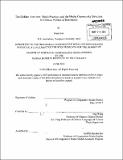| dc.contributor.advisor | Jing Wang. | en_US |
| dc.contributor.author | Sun, Huan, S.M. Massachusetts Institute of Technology | en_US |
| dc.contributor.other | Massachusetts Institute of Technology. Department of Comparative Media Studies. | en_US |
| dc.coverage.spatial | a-cc--- | en_US |
| dc.date.accessioned | 2013-09-24T19:45:09Z | |
| dc.date.available | 2013-09-24T19:45:09Z | |
| dc.date.copyright | 2013 | en_US |
| dc.date.issued | 2013 | en_US |
| dc.identifier.uri | http://hdl.handle.net/1721.1/81135 | |
| dc.description | Thesis (S.M.)--Massachusetts Institute of Technology, Dept. of Comparative Media Studies, 2013. | en_US |
| dc.description | Cataloged from PDF version of thesis. | en_US |
| dc.description | Includes bibliographical references (p. 94-99). | en_US |
| dc.description.abstract | My thesis discusses the hidden and non-adversarial nature of resistance in authoritarian countries through the perspectives of media practices and media opportunity structure. To understand the art of resistance in authoritarian countries, one has to look beyond the striking physical confrontational aspect of resistance. I approach the topic of hidden resistance by examining the social and cultural implications of media artifacts appropriated by movement participants and their strategic interactions with different stakeholders within the media ecosystem. Using media practices and the media opportunity structure as analytical lenses, I conduct case studies on three movements. The first case, Wukan Protest in 2011, which was a local protest against land expropriation, illustrates the essence of non-adversarial resistance in a confrontational incident. Wukan protesters' media practices helped them take advantage of the opportunity structure. The second case examines how New Workers Art Group (NWAG), a nonprofit organization in Beijing, actively produces alternative discourses as resistance to hegemonic urban values. Migrant workers collective identities are constructed through their self-produced media artifacts. The third case looks at how New Rural Reconstruction (NRR) movement leverages mainstream discourses and conducted a series of experiments aiming to change economic, social, and cultural relationships in rural China. The diversity of cases is to obtain more complex view on real-life contention and avoid oversimplifying the thick meaning of "hidden transcript" across different movements. The thesis concludes that the success of hidden resistance cannot be solely defined by mainstream media visibility. Looking beyond confrontations portrayed in media reporting, this thesis argues that participants' practices of alternative media forms assist them in mobilization and organization, and resistors' strategic interactions with different players in media system create opportunities for them to continuously implement incremental social change on the ground. | en_US |
| dc.description.statementofresponsibility | by Huan Sun. | en_US |
| dc.format.extent | 99 p. | en_US |
| dc.language.iso | eng | en_US |
| dc.publisher | Massachusetts Institute of Technology | en_US |
| dc.rights | M.I.T. theses are protected by
copyright. They may be viewed from this source for any purpose, but
reproduction or distribution in any format is prohibited without written
permission. See provided URL for inquiries about permission. | en_US |
| dc.rights.uri | http://dspace.mit.edu/handle/1721.1/7582 | en_US |
| dc.subject | Comparative Media Studies. | en_US |
| dc.title | The hidden activism : media practices and the media opportunity in Chinese politics of resistance | en_US |
| dc.title.alternative | Media practices and the media opportunity in Chinese politics of resistance | en_US |
| dc.type | Thesis | en_US |
| dc.description.degree | S.M. | en_US |
| dc.contributor.department | Massachusetts Institute of Technology. Program in Comparative Media Studies/Writing | en_US |
| dc.identifier.oclc | 858281344 | en_US |
